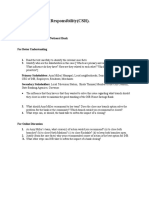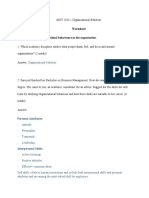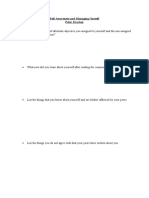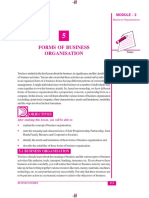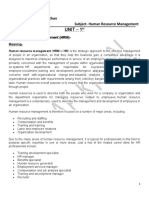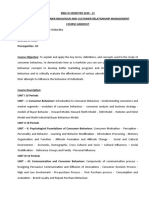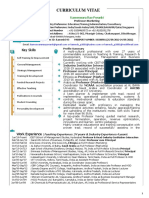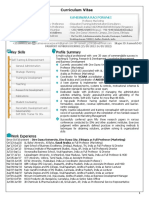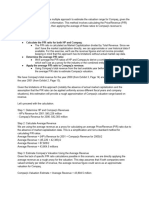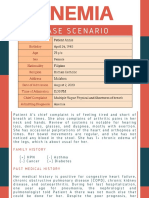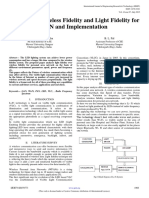0 ratings0% found this document useful (0 votes)
144 viewsCB Lesson Plan
CB Lesson Plan
Uploaded by
Kameswara Rao PorankiThis lesson plan outlines a consumer behavior course taught over 36 periods. It is divided into 5 units that will be covered across the semester. Unit I provides an introduction to consumer behavior and key concepts. Unit II focuses on learning theories and information processing. Unit III examines social and cultural influences on consumption. Unit IV analyzes the consumer decision-making process. Finally, Unit V presents several models of consumer decision making, including contemporary models and those proposed by Howard-Sheth, Engel-Blackwell, and Rao-Lilien.
Copyright:
© All Rights Reserved
Available Formats
Download as DOCX, PDF, TXT or read online from Scribd
CB Lesson Plan
CB Lesson Plan
Uploaded by
Kameswara Rao Poranki0 ratings0% found this document useful (0 votes)
144 views1 pageThis lesson plan outlines a consumer behavior course taught over 36 periods. It is divided into 5 units that will be covered across the semester. Unit I provides an introduction to consumer behavior and key concepts. Unit II focuses on learning theories and information processing. Unit III examines social and cultural influences on consumption. Unit IV analyzes the consumer decision-making process. Finally, Unit V presents several models of consumer decision making, including contemporary models and those proposed by Howard-Sheth, Engel-Blackwell, and Rao-Lilien.
Original Description:
MBA LESSON PLAN ON CONSUMER BEHAVIOR
Original Title
CB lesson plan (1) (1)
Copyright
© © All Rights Reserved
Available Formats
DOCX, PDF, TXT or read online from Scribd
Share this document
Did you find this document useful?
Is this content inappropriate?
This lesson plan outlines a consumer behavior course taught over 36 periods. It is divided into 5 units that will be covered across the semester. Unit I provides an introduction to consumer behavior and key concepts. Unit II focuses on learning theories and information processing. Unit III examines social and cultural influences on consumption. Unit IV analyzes the consumer decision-making process. Finally, Unit V presents several models of consumer decision making, including contemporary models and those proposed by Howard-Sheth, Engel-Blackwell, and Rao-Lilien.
Copyright:
© All Rights Reserved
Available Formats
Download as DOCX, PDF, TXT or read online from Scribd
Download as docx, pdf, or txt
0 ratings0% found this document useful (0 votes)
144 views1 pageCB Lesson Plan
CB Lesson Plan
Uploaded by
Kameswara Rao PorankiThis lesson plan outlines a consumer behavior course taught over 36 periods. It is divided into 5 units that will be covered across the semester. Unit I provides an introduction to consumer behavior and key concepts. Unit II focuses on learning theories and information processing. Unit III examines social and cultural influences on consumption. Unit IV analyzes the consumer decision-making process. Finally, Unit V presents several models of consumer decision making, including contemporary models and those proposed by Howard-Sheth, Engel-Blackwell, and Rao-Lilien.
Copyright:
© All Rights Reserved
Available Formats
Download as DOCX, PDF, TXT or read online from Scribd
Download as docx, pdf, or txt
You are on page 1of 1
LESSON PLAN
Department : SMS Class: MBA-B
Academic Year : 2019-2020 Semester: IV-Sem
Subject : Consumer Behaviour Subject Code: 16MB E115 (M)
Faculty : Prof.P.Kameswara Rao No. of periods: 36
Commencement of Instruction : 16-12-19
Date of I Mid Exam : II mid exam:
Classes lost due to Holidays and Mid-Sessional Exams
Day& Date
Occasion
Units Topic No. of cumulative
periods
Unit –I: Introduction, Definition, Evolution, Contemporary Dimensions of Consumer Behaviour 1 2
CB Research Process, Buyers and Users 1 3
Development of Marketing Concept, Consumer Behaviour and its Applications in 1 4
Marketing
Concepts of motivation and personality, perception and their marketing implications. 1 5
Unit –II: Concept of learning, important aspects of learning Process 1+1 7
Concepts of conditioning
Important aspects of information processing theory 1+1 9
Encoding and information retention, Retrieval of Information, Split – brain theory. 1+1 11
Unit –III: Social and cultural settings- Culture, subculture and Cross cultural Marketing practices 1+1 13
Family life cycle-1,2,3 and Reference groups
Personality- Theories, Life style Influences 1+1 15
AIO and VALS Framework. Ethno Centrism 1+1 17
Unit-IV: Meaning of Decision Making, Different views 1+1 19
Buying Motives, Types of decision making process in buying 1+1 21
Consumer Information processing- Information search, Evaluation of alternatives 1+1 23
Purchasing Process, Post purchase behaviour 1+1 25
Consumer action and disposable of products 1+1 27
Unit-V: Models of Consumer Decision making Process 1 28
Contemporary models, Generic Model of Consumer Behaviour 1 29
Howard Sheth Model 1 30
Engel Blackwell and Rao-Lilien model 1+1 32
Role of Consumerism 1+1 34
1+1 36
Signature of faculty Signature of HOD
You might also like
- Indigo Assignment - Sara Gabrielle Leal RibeiroDocument10 pagesIndigo Assignment - Sara Gabrielle Leal RibeirosaramlealNo ratings yet
- Corporate Social Responsibility THESISDocument1 pageCorporate Social Responsibility THESISminda_esperida37060% (1)
- Could Your Personality Derail Your CareerDocument5 pagesCould Your Personality Derail Your CareerDiya BasuNo ratings yet
- CLO 1 - OB and Individual Behaviour - WorksheetDocument7 pagesCLO 1 - OB and Individual Behaviour - WorksheetaishaNo ratings yet
- Fme Effective CommunicationDocument45 pagesFme Effective CommunicationMuhammad Mubeen Iqbal PuriNo ratings yet
- Sapamine CSN Textile Softener: Technical Data SheetDocument5 pagesSapamine CSN Textile Softener: Technical Data Sheetsasko100% (1)
- Atkins DietDocument10 pagesAtkins Dietfenny100% (1)
- Lesson Plan Consumer BehaviourDocument5 pagesLesson Plan Consumer BehaviourPrabhakar RaoNo ratings yet
- CBI Session Plan. BalasudarsunDocument2 pagesCBI Session Plan. BalasudarsunPankaj ChandiramaniNo ratings yet
- Dimensions of Interpersonal RelationshipsDocument10 pagesDimensions of Interpersonal Relationshipsasif razaNo ratings yet
- Mentee Manual: Career Mentoring ProgramDocument11 pagesMentee Manual: Career Mentoring Programsamknight2009No ratings yet
- Managing OneselfDocument3 pagesManaging OneselfKhushboo GargNo ratings yet
- Organizational Behavior and DevelopmentDocument22 pagesOrganizational Behavior and Developmentወዲ ተስፋይ ገብረዮሱስNo ratings yet
- Managerial SkillsDocument30 pagesManagerial SkillsShefali Damon SalvatoreNo ratings yet
- Industrial RelationsDocument252 pagesIndustrial RelationsappajishirurNo ratings yet
- Contemporary Framework of Management: Unit - 1 Emotional Intelligence MCQDocument45 pagesContemporary Framework of Management: Unit - 1 Emotional Intelligence MCQAjay KareNo ratings yet
- Assess The Impact of Ineffective Communications On Working Relationships and Performance Standards 1.2Document2 pagesAssess The Impact of Ineffective Communications On Working Relationships and Performance Standards 1.2Ashique BhuiyanNo ratings yet
- 3ppd - Interpersonal Relationship at Workplace - VenturadoDocument27 pages3ppd - Interpersonal Relationship at Workplace - VenturadoJoan Mae VenturadoNo ratings yet
- Fair and Unfair PracticesDocument22 pagesFair and Unfair PracticesDixita ParmarNo ratings yet
- Indian Manager's Attitudes Towards Business EthicsDocument10 pagesIndian Manager's Attitudes Towards Business EthicsGaurav Srivastava100% (3)
- Feedback in Communication: Prof. Pooja MohantyDocument20 pagesFeedback in Communication: Prof. Pooja MohantyManju EkkaNo ratings yet
- l5 - Forms of Business OrganisationDocument28 pagesl5 - Forms of Business OrganisationTeachingTrainingCoaching KnowledgeSharingSessionNo ratings yet
- Chapter 8 FINAL Collaborative Partnership Among StakeholdersDocument20 pagesChapter 8 FINAL Collaborative Partnership Among StakeholdersebsaNo ratings yet
- 3b Asyraf Wajdi DusukiDocument21 pages3b Asyraf Wajdi Dusukispucilbroz100% (1)
- Employees' Perception of Organizational Climate and Its Implications For Organizational Effectiveness in Amhara Regional Public Service OrgansDocument157 pagesEmployees' Perception of Organizational Climate and Its Implications For Organizational Effectiveness in Amhara Regional Public Service OrgansMesfin624No ratings yet
- Nba Sar FormatDocument38 pagesNba Sar FormatRamling PatrakarNo ratings yet
- D - B. R. Ambedkar Open UniversityDocument23 pagesD - B. R. Ambedkar Open UniversityAnderson SilvaNo ratings yet
- Personality TheoriesDocument10 pagesPersonality Theorieskebede desalegnNo ratings yet
- Emotional IntelligenceDocument19 pagesEmotional IntelligenceLakshya SaxenaNo ratings yet
- Managerial Communication Course OutlineDocument4 pagesManagerial Communication Course OutlineVishal JoshiNo ratings yet
- Organisational ConflictDocument17 pagesOrganisational ConflictBijay Jha100% (1)
- Firo-B: Fundamental Interpersonal Relations OrientationDocument8 pagesFiro-B: Fundamental Interpersonal Relations Orientationsumit.jainNo ratings yet
- Management Ethics Meaning Need and ImportanceDocument11 pagesManagement Ethics Meaning Need and ImportanceAbdullah MujahidNo ratings yet
- Sadaf BBA HRM NotesDocument75 pagesSadaf BBA HRM NotesAayushi SinghNo ratings yet
- Communication Skills JournalDocument4 pagesCommunication Skills Journalapi-358958478100% (1)
- Conflict Management in OrganizationDocument12 pagesConflict Management in OrganizationHaniya Ch100% (1)
- Case StudyDocument3 pagesCase StudyNeetika ShrivastavaNo ratings yet
- U-3 UNIT 3 INTERPERSONAL BEHAVIOR 8 HrsDocument26 pagesU-3 UNIT 3 INTERPERSONAL BEHAVIOR 8 HrsVarsha GowdaNo ratings yet
- HRD Intervention: Counseling, Coaching & MentoringDocument28 pagesHRD Intervention: Counseling, Coaching & MentoringS M Arefin ShahriarNo ratings yet
- Chapter1 Introduction To Management ProcessDocument4 pagesChapter1 Introduction To Management Processsuhaib1282No ratings yet
- Perception and Its ImportanceDocument8 pagesPerception and Its ImportanceAzra IshratNo ratings yet
- Module 3 Leadership and TeamworkDocument4 pagesModule 3 Leadership and TeamworkKyl CajesNo ratings yet
- MODULE 2-2.2 Technology Enabled CommunicationDocument25 pagesMODULE 2-2.2 Technology Enabled CommunicationmanthanjaniNo ratings yet
- Transactional Analysis - Johari Window - OBDocument28 pagesTransactional Analysis - Johari Window - OBM.MONIKANo ratings yet
- HRM hw1 FeedbackDocument2 pagesHRM hw1 FeedbackLindaNo ratings yet
- Effective Communication, Types, Importance Benifits and Pros and ConsDocument9 pagesEffective Communication, Types, Importance Benifits and Pros and ConsNauman MashwaniNo ratings yet
- Case Study: Conflicts Over Privacy in The WorkplaceDocument3 pagesCase Study: Conflicts Over Privacy in The WorkplaceHaris MunirNo ratings yet
- Entrepreneurship Development Workbook For LearnersDocument311 pagesEntrepreneurship Development Workbook For LearnersNoah Mzyece DhlaminiNo ratings yet
- Dealing Well With Cross-TrainingDocument14 pagesDealing Well With Cross-TrainingRoberto Lico ReisNo ratings yet
- Directorate of Technical Education NBA-Cell Session-1 Self Assessment Report (Sar) - FillingDocument42 pagesDirectorate of Technical Education NBA-Cell Session-1 Self Assessment Report (Sar) - FillingHarsha SamagaraNo ratings yet
- Business Ethics and Corporate GovernanceDocument37 pagesBusiness Ethics and Corporate Governancebabujaya851No ratings yet
- Management & Oraganization: Assignment No. 1Document23 pagesManagement & Oraganization: Assignment No. 1umer bin abidNo ratings yet
- Akhil - Terrorist Attack in The Taj Mahal PalaceDocument19 pagesAkhil - Terrorist Attack in The Taj Mahal Palaceakhilyerawar7013No ratings yet
- Criteria V NBADocument17 pagesCriteria V NBAK.SUBRAMANINo ratings yet
- Strategic Human Resource Mgmt. CH 1 Pulak DasDocument15 pagesStrategic Human Resource Mgmt. CH 1 Pulak DasPareen Joshi100% (2)
- Retirement and Death of A PartnerDocument36 pagesRetirement and Death of A PartnerArunima JainNo ratings yet
- Question Bank Indian Ethos and Values (First Semester) Unit-I 2 Mark QuestionsDocument5 pagesQuestion Bank Indian Ethos and Values (First Semester) Unit-I 2 Mark Questionsrajamba2011No ratings yet
- Questionnaire Business ResearchDocument9 pagesQuestionnaire Business ResearchjebatmalanglagiNo ratings yet
- Ethics PDFDocument204 pagesEthics PDFSUDHAKAR reddyNo ratings yet
- CBCRM Course HandoutDocument4 pagesCBCRM Course HandoutNeha SmileyNo ratings yet
- NBS 7025A - Lecture 7 - Customer Analysis - Nov 2023-24 - V2Document81 pagesNBS 7025A - Lecture 7 - Customer Analysis - Nov 2023-24 - V2rahimmujtabahNo ratings yet
- MBA II Sem - MGMT407 - Consumer Behavior - Abhinav Nigam - Abhinav NigamDocument4 pagesMBA II Sem - MGMT407 - Consumer Behavior - Abhinav Nigam - Abhinav NigamQala LimitedNo ratings yet
- Principal MBADocument18 pagesPrincipal MBAKameswara Rao PorankiNo ratings yet
- Insurance ServicesDocument2 pagesInsurance ServicesKameswara Rao PorankiNo ratings yet
- Prof - Rao CV October 2019Document18 pagesProf - Rao CV October 2019Kameswara Rao PorankiNo ratings yet
- Integrated Marketing Communications: Module 4: Developing The IMC ProgramDocument97 pagesIntegrated Marketing Communications: Module 4: Developing The IMC ProgramKameswara Rao PorankiNo ratings yet
- Content ServerDocument13 pagesContent ServerKameswara Rao PorankiNo ratings yet
- Creative Strategy DevelopmentDocument13 pagesCreative Strategy DevelopmentKameswara Rao PorankiNo ratings yet
- MBA SyllabusDocument59 pagesMBA SyllabusKameswara Rao PorankiNo ratings yet
- FINANCE Project Finance - Practical Case Studies Vol I, 2nd Ed - 1855648458Document8 pagesFINANCE Project Finance - Practical Case Studies Vol I, 2nd Ed - 1855648458Kameswara Rao PorankiNo ratings yet
- Consumer Behavior SyllabusDocument2 pagesConsumer Behavior SyllabusKameswara Rao Poranki100% (2)
- Mba (Integrated) Curriculum and Syllabi 2014-2015Document288 pagesMba (Integrated) Curriculum and Syllabi 2014-2015Kameswara Rao PorankiNo ratings yet
- Jamsa Report 2018Document3 pagesJamsa Report 2018Kameswara Rao PorankiNo ratings yet
- Igmsa: Indian Grand Master Sports AcademyDocument6 pagesIgmsa: Indian Grand Master Sports AcademyKameswara Rao PorankiNo ratings yet
- Business Communication: Jocelyn I. BartolataDocument17 pagesBusiness Communication: Jocelyn I. BartolataKameswara Rao PorankiNo ratings yet
- MBA SyllabusDocument59 pagesMBA SyllabusKameswara Rao PorankiNo ratings yet
- Sri Venkateswara Vajra Kavacha StotramDocument1 pageSri Venkateswara Vajra Kavacha StotramKameswara Rao PorankiNo ratings yet
- A Comparative Analysis of Advanced Planning and Scheduling and Supply Chain Management Practices in India and EthiopiaDocument1 pageA Comparative Analysis of Advanced Planning and Scheduling and Supply Chain Management Practices in India and EthiopiaKameswara Rao PorankiNo ratings yet
- SeminarDocument11 pagesSeminarKameswara Rao PorankiNo ratings yet
- Mba Curriculum FinalDocument53 pagesMba Curriculum FinalKameswara Rao Poranki80% (5)
- Key Skills Profile Summary: Curriculum VitaeDocument16 pagesKey Skills Profile Summary: Curriculum VitaeKameswara Rao PorankiNo ratings yet
- Finaldraft Project DsirDocument27 pagesFinaldraft Project DsirKameswara Rao PorankiNo ratings yet
- Q3 - What Is The Appropriate Valuation Range For CompaqDocument2 pagesQ3 - What Is The Appropriate Valuation Range For Compaqvikas joshiNo ratings yet
- CP Fase A (Kelas 1-2)Document9 pagesCP Fase A (Kelas 1-2)Anggi Fika SumarnaNo ratings yet
- Surat Lamaran Kerja Bahasa InggrisDocument4 pagesSurat Lamaran Kerja Bahasa InggrisSiska PurwatiNo ratings yet
- G5RV Louis VarneyDocument6 pagesG5RV Louis VarneyDiego García MedinaNo ratings yet
- ISCA Important QuestionsDocument20 pagesISCA Important QuestionsRupesh NiralaNo ratings yet
- 33-TDC - Company Profile 2022Document37 pages33-TDC - Company Profile 2022nika daraNo ratings yet
- Field Methods in Psych by PartnerDocument3 pagesField Methods in Psych by PartnerChin Dela CruzNo ratings yet
- Number Opened State Pending Reason Close Code Close Code Requested byDocument20 pagesNumber Opened State Pending Reason Close Code Close Code Requested byPrabakaran BalasubramaniamNo ratings yet
- Chapter 5 Regression AnalysisDocument14 pagesChapter 5 Regression AnalysisLeslie Anne BiteNo ratings yet
- COVID-19 Vaccine Information SheetDocument11 pagesCOVID-19 Vaccine Information SheetKirbyCronoNo ratings yet
- HW Tender PDFDocument59 pagesHW Tender PDFJashika PattnaikNo ratings yet
- Kesoram CementDocument72 pagesKesoram CementPrem Raj100% (3)
- "Kodak": Strategic ManagementDocument9 pages"Kodak": Strategic ManagementKyohyunNo ratings yet
- Eun7e CH 008Document44 pagesEun7e CH 008Shruti AshokNo ratings yet
- School Form 8 Learner Basic Health and Nutrition ReportDocument9 pagesSchool Form 8 Learner Basic Health and Nutrition ReportJayson MangubatNo ratings yet
- Two Methods of Preparing Frozen Sections May Be Resorted To: 1. Cold Knife Procedure 2. Cryostat Procedure (Cold Microtome) Cold Knife ProcedureDocument2 pagesTwo Methods of Preparing Frozen Sections May Be Resorted To: 1. Cold Knife Procedure 2. Cryostat Procedure (Cold Microtome) Cold Knife ProcedureZairah Pascua100% (1)
- BS 5234-Part2 - Crowd Pressure TestDocument2 pagesBS 5234-Part2 - Crowd Pressure TestRoland ArimadoNo ratings yet
- Practical Research 1 Quarter 1 - Module 14: What's The Problem?Document11 pagesPractical Research 1 Quarter 1 - Module 14: What's The Problem?Mark Allen Labasan100% (1)
- K Pfitzner, X and G Staben: Program Leader, Spatial Sciences and Data IntegrationDocument25 pagesK Pfitzner, X and G Staben: Program Leader, Spatial Sciences and Data IntegrationNT SpatialNo ratings yet
- Erotica Money System: Instantly Stuff Rock Hard Cash in Your Bank Account!Document24 pagesErotica Money System: Instantly Stuff Rock Hard Cash in Your Bank Account!Marcus McCain67% (3)
- Port Monitor-MirrorDocument16 pagesPort Monitor-MirrorHai LeNo ratings yet
- Anemia PDFDocument11 pagesAnemia PDFRegieLimos100% (1)
- (TEST 1) - ĐỀ TRẮC NGHIỆM VDC MÔN TIẾNG ANH 2021Document1 page(TEST 1) - ĐỀ TRẮC NGHIỆM VDC MÔN TIẾNG ANH 2021buiphuongthuyvv2005No ratings yet
- Pass College Senior High School Department Oral Communication Quiz 1Document2 pagesPass College Senior High School Department Oral Communication Quiz 1Hazel Abella100% (1)
- Alex Borger-Cv PDFDocument2 pagesAlex Borger-Cv PDFapi-271690717No ratings yet
- Analysis of Wireless Fidelity and Light Fidelity For PAN and ImplementationDocument6 pagesAnalysis of Wireless Fidelity and Light Fidelity For PAN and ImplementationAnn RazonNo ratings yet
- Gujarat Technological University, Ahmedabad, Gujarat Course Curriculum Course Title: CourseDocument6 pagesGujarat Technological University, Ahmedabad, Gujarat Course Curriculum Course Title: CourseSher Hai HamNo ratings yet
- Hedgehog Structure-Estructura ErizoDocument18 pagesHedgehog Structure-Estructura ErizojavegaraposoNo ratings yet

